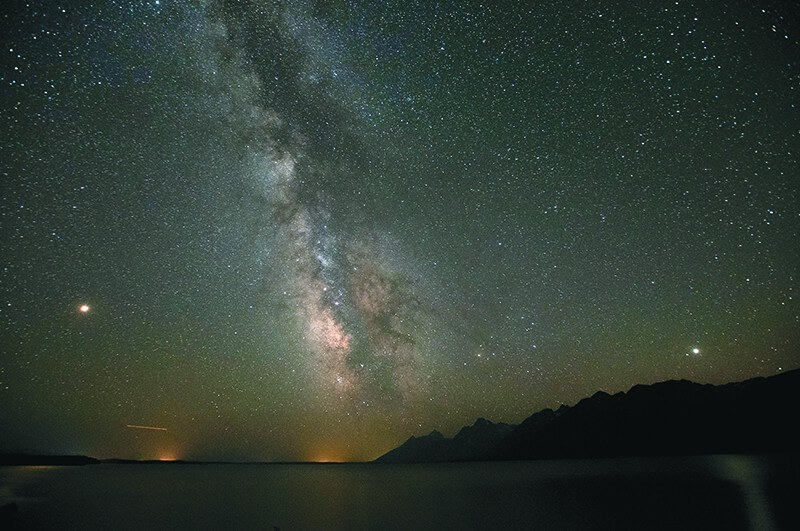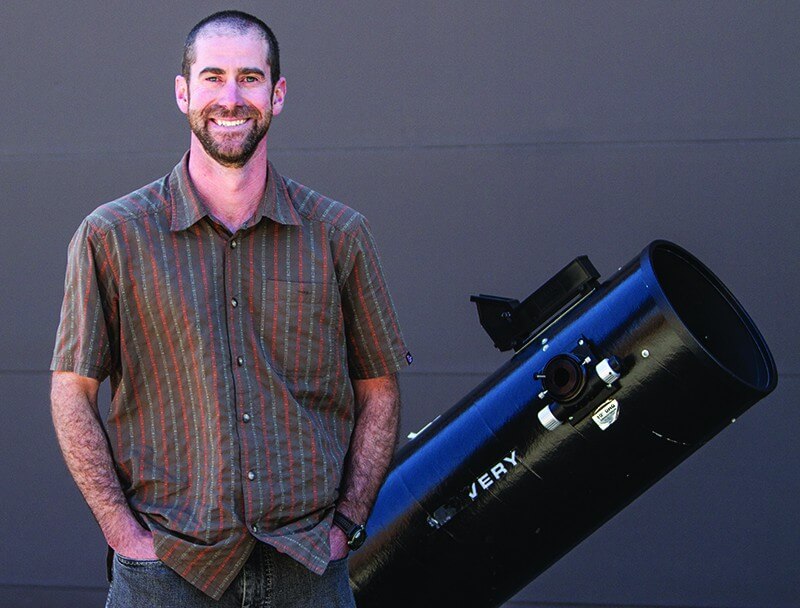Read The
Current Issue
Party with the Stars
Yeah, Justin Bieber was here last weekend, and Sandra Bullock and Robert Downey Jr. are regular visitors, but they aren’t Jackson Hole’s best stars.
By Dina Mishev

The Milky Way spreads over Jackson Lake on a moonless night in Grand Teton National Park. The glow of lights in Jackson and Wilson is visible on the horizon. Photo by Bradly J. Boner
YOU CAN GO out for drinks or to a concert almost anywhere. You can’t see the Milky Way from anywhere. In fact, because of increasing light pollution around the planet, you can’t see the Milky Way from most places. Researchers at Italy’s Light Pollution Science and Technology Institute found that two out of three Europeans and four out of five Americans cannot see the 100-billion star galaxy to which our solar system belongs from their homes. Where can you see the Milky Way? In Grand Teton and Yellowstone National Parks, and national forestland adjacent to both. In the parks, alongside the Milky Way you’ll also see about five thousand stars and the Triangulum Galaxy, which is approximately three million light-years from Earth. And this is just with your naked eye. Sign on for a private stargazing safari offered by Wyoming Stargazing and you can see even more through its large lens telescopes.
“It’s like a wildlife tour, except we go out and see stars,” says Dr. Samuel Singer, who has a PhD in science education and founded Wyoming Stargazing in 2013. Singer and his staff do stargazing safaris year-round. (Wyoming Stargazing, a nonprofit, also offers public stargazing programs, solar astronomy programs, and planetarium programs.) “We get people to explore the extraordinary in the ordinary. The sky is always above our heads, we normally just don’t look up, and there is so much cool stuff up there day and night, especially here, where we’re lucky to have pretty dark skies.” The reason dark skies are so hard to find today? Light pollution, a collective term that includes all forms of artificial light, but most conspicuously the perpetual sky glow that hovers over urban areas.
WHILE GRAND TETON and Yellowstone National Parks are not recognized by the International Dark-Sky Association (IDA) for their dark skies, both parks rate well on the nine-level Bortle Scale, which measures darkness of a particular location. (No place in Wyoming is recognized by the IDA, but this is due to a lack of applying for IDA recognition rather than the state’s skies not being dark enough to qualify.) Developed by amateur astronomer John E. Bortle in 2001, the Bortle Scale ranges from Class 1, the darkest skies available on Earth, through Class 9, inner-city skies. The Town of Jackson itself comes it at a 5, a “suburban sky” in which light pollution is visible in most, if not all, directions and the Milky Way is very weak or invisible near the horizon, and looks washed out overhead. Get away from Jackson’s bright lights, though, and the skies above Grand Teton and Yellowstone National Parks are Class 3. In Class 3 skies, the summer Milky Way appears complex and the Triangulum Galaxy (also known as M33) is visible using averted vision.
The brightest beam of light on Earth shoots from the apex of the Luxor casino’s pyramid in Las Vegas—thirty-nine xenon lamps, each 6 feet tall and 3 feet wide. The beam is equal to the light of more than forty billion candles. To put this in historic perspective: In 1688, Louis XIV wanted to showcase his wealth and power with maximum illumination at Versailles; he was able to gather 24,000 candles.
“We have some of the darkest skies of anywhere in the country,” Singer says. “A few places are darker—national parks in the Southwest, which have drier air and are father from cities—but Jackson Hole still has amazingly dark night skies.” Singer says his favorite moment of every stargazing program is when he parks at the spot he will set up the telescope and the night’s stargazers exit the van. “I turn the headlights off and everyone steps outside under this big, dark sky, and they’re just blown away. I think some people get dizzy when they look up. It feels like you’re in a fishbowl.” There’s a lovely term that describes this feeling—when the horizon disappears and you feel like you’re falling into the stars: “celestial vaulting.” You can do this vaulting on your own by driving up to the park after the sun sets. We like the summit of Signal Mountain, which there is a road to, Mormon Row on Antelope Flats Road, the Cunningham Cabin, and the Snake River Overlook. “But you can really pull over almost anywhere in the park and look up and be blown away,” Singer says.
You do need Wyoming Stargazing and its large lens telescopes to go deeper into the cosmos, though. Once Singer has a telescope out and is ready to go—this takes about fifteen to thirty minutes, and while you wait, there are hot cider and hot chocolate and virtual reality goggles that you can use with an app to learn about the night sky—things get next-level. “I love when people look through the telescope and see the rings of Saturn,” Singer says. “People get super psyched to see something they’ve only ever seen in photos before. There are lots of ‘Oh my Gods,’ ‘Holy sh8*%,’ and other profanities,” he says.
Two out of three Europeans and four out of five Americans cannot see the 100-billion star galaxy to which our solar system belongs from their homes.
A stargazing safari isn’t just about looking, though. “We tell stories about these objects,” Singer says. “People are looking at fuzzy spots that are the accumulated light of billions of stars from tens of millions of light-years away. That’s looking into the past. That light you’re seeing through a telescope one night in 2019 in Grand Teton National Park took tens of millions of years to get here. We’re literally seeing the universe as it existed millions of years ago. I never get tired of telling this story.”
For a schedule of Wyoming Stargazing’s public programs, go to wyomingstargazing.org. Private stargazing safaris are $500 for up to 2 people and $175/person for 3-13 people. Book by calling 844/WYO-STAR (844/996-7827). Multigroup stargazing safaris combine families together on the same program and are offered June through September. They are $115/person and have no more than 13 people total in the group.
The Bortle Scale

Photo by Bradly J. Boner

Dr. Samuel Singer founded Wyoming Stargazing in 2013. Photo by Ryan Jones

People gather for a free Wyoming Stargazing event at the Jackson Hole & Greater Yellowstone Visitor Center. Photo by Amber Baesler




